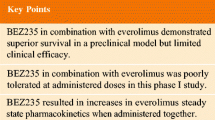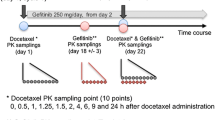Abstract
Purpose
There are several reasons why combining an inhibitor of the vascular endothelial and the platelet-derived growth factor receptor with a taxane might induce synergistic antitumor activity. This phase I study aimed to determine the maximal tolerated dose (MTD) of the combination of pazopanib with two different schedules of docetaxel.
Methods
In a 3 + 3 + 3 design, patients with advanced solid tumors received escalating doses of oral pazopanib combined with docetaxel given either every 3 weeks (D3w) or weekly at days 1, 8, and 15 every 28 days (D1w). Pharmacokinetic data of docetaxel and pazopanib were obtained through extensive sampling and WinNonlin modeling.
Results
Forty-six patients were enrolled to six dose levels. Both schedules of docetaxel could be combined with 400 mg/day pazopanib. The MTD of D3w docetaxel was 50 mg/m2, while for D1w MTD, it was 20 mg/m2. In the D3w schedule, the administration of pazopanib led to a 33 % lower docetaxel clearance (mean 31.5 vs 21.1 L/h/m2; P = 0.019) and >50 % increase in AUC0-∞ (mean 1,602 vs 2,414 ng*h/mL; P = 0.029) compared with docetaxel single-agent data. Data for the D1w schedule were comparable.
Conclusions
Both treatment schedules of docetaxel combined with pazopanib are feasible but at doses for both drugs that are considerably lower than the recommended single-agent doses. This is largely due to a clinically relevant pharmacokinetic interaction with pazopanib, substantially increasing docetaxel exposure. This interaction is most likely due to CYP3A4 and OATP1B1 inhibition.


Similar content being viewed by others
References
Boere IA, Hamberg P, Sleijfer S (2010) It takes two to tango: combinations of conventional cytotoxics with compounds targeting the VEGF-VEGFR pathway in patients with solid malignancies. Cancer Sci 101:7–15
Hamberg P, Verweij J, Sleijfer S (2010) (Pre-)clinical pharmacology and activity of pazopanib, a novel multikinase angiogenesis inhibitor. Oncologist 15:539–547
Sternberg CN, Davis ID, Mardiak J et al (2010) Pazopanib in locally advanced or metastatic renal cell carcinoma: results of a randomized phase III trial. J Clin Oncol 28:1061–1068
Van der Graaf WT, Blay JY, Chawla SP et al (2012) Pazopanib for metastatic soft-tissue sarcoma (PALETTE): a randomised, double blind, placebo-controlled phase 3 trial. Lancet 379:1879–1886
Shibata SI, Chung V, Synold TW et al (2013) Phase I study of pazopanib in patients with advanced solid tumors and hepatic dysfunction: a National Cancer Institute Organ Dysfunction Working Group study. Clin Cancer Res 19:3631–3639
Van Leeuwen RW, van Gelder T, Mathijssen RH, Jansman FG (2014) Drug-drug interactions with tyrosine kinase inhibitors: a clinical perspective. Lancet Oncol 15:e315–e326
Engels FK, ten Tije AJ, Baker SD et al (2004) Effect of cytochrome P450 3A4 inhibition on the pharmacokinetics of docetaxel. Clin Pharmacol Ther 75:448–454
Goey AK, Meijerman I, Rosing H et al (2014) The effect of St John’s wort on the pharmacokinetics of docetaxel. Clin Pharmacokin 53:103–110
De Graan AJ, Lancaster CS, Obaidat A et al (2012) Influence of polymorphic OATP1B-type carriers on the disposition of docetaxel. Clin Cancer Res 18:4433–4440
Eisenhauer EA, Therasse P, Bogaerts J et al (2009) New response evaluation criteria in solid tumours: revised RECIST guideline (version 1.1). Eur J Cancer 45:228–247
Hamberg P, Ratain MJ, Lesaffre E, Verweij J (2010) Dose-escalation models for combination phase I trials in oncology. Eur J Cancer 46:2870–2878
De Graan AJ, Loos WJ, Friberg LE et al (2012) Influence of smoking on the pharmacokinetics and toxicity profiles of taxane therapy. Clin Cancer Res 18:4425–4432
Hurwitz HI, Dowlati A, Saini S et al (2009) Phase I trial of pazopanib in patients with advanced cancer. Clin Cancer Res 15:4220–4227
Awada A, Hendlisz A, Christensen O et al (2012) Phase I trial to investigate the safety, pharmacokinetics and efficacy of sorafenib combined with docetaxel in patients with advanced refractory solid tumours. Eur J Cancer 48:465–474
Martin LP, Kozloff MF, Herbst RS et al (2012) Phase I study of axitinib combined with paclitaxel, docetaxel or capecitabine in patients with advanced solid tumours. Br J Cancer 107:1268–1276
Harris JW, Rahman A, Kim BR, Guengerich FP, Collins JM (1994) Metabolism of taxol by human hepatic microsomes and liver slices: participation of cytochrome P450 3A4 and an unknown P450 enzyme. Cancer Res 54:4026–4035
Tan AR, Dowlati A, Jones SF et al (2010) Phase I study of pazopanib in combination with weekly paclitaxel in patients with advanced solid tumors. Oncologist 15:1253–1261
Hu S, Mathijssen RHJ, de Bruijn P, Baker S, Sparreboom A (2014) Inhibition of OATP1B1 by tyrosine kinase inhibitors: in vitro-in vivo correlations. Br J Cancer 110:894–898
Du Bois A, Vergote I, Wimberger P et al (2012) Open-label feasibility study of pazopanib, carboplatin and paclitaxel in women with newly diagnosed, untreated, gynaecologic tumours: a phase I/II trial of the AGO study group. Br J Cancer 106:629–632
Burris HA 3rd, Dowlati A, Moss RA et al (2012) Phase I study of pazopanib in combination with paclitaxel and carboplatin given every 21 days in patients with advanced solid tumors. Mol Cancer Ther 11:1820–1828
Acknowledgments
This is an investigator-initiated trial financially supported by GSK.
Conflict of interest
C Leonowens is an employee of GSK (pazopanib); the others reported to have no conflicts of interest.
Author information
Authors and Affiliations
Corresponding author
Additional information
Dutch Trial Registry number: NTR 2309.
Electronic supplementary material
Below is the link to the electronic supplementary material.
Rights and permissions
About this article
Cite this article
Hamberg, P., Mathijssen, R.H.J., de Bruijn, P. et al. Impact of pazopanib on docetaxel exposure: results of a phase I combination study with two different docetaxel schedules. Cancer Chemother Pharmacol 75, 365–371 (2015). https://doi.org/10.1007/s00280-014-2655-x
Received:
Accepted:
Published:
Issue Date:
DOI: https://doi.org/10.1007/s00280-014-2655-x




